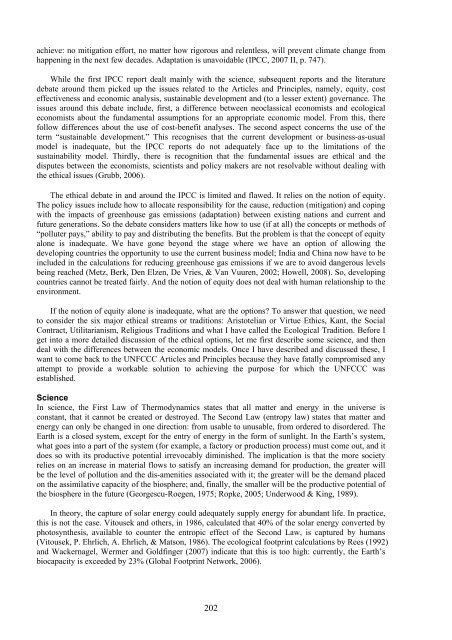traditional knowledge conference 2008 te tatau pounamu
traditional knowledge conference 2008 te tatau pounamu
traditional knowledge conference 2008 te tatau pounamu
You also want an ePaper? Increase the reach of your titles
YUMPU automatically turns print PDFs into web optimized ePapers that Google loves.
achieve: no mitigation effort, no mat<strong>te</strong>r how rigorous and relentless, will prevent clima<strong>te</strong> change fromhappening in the next few decades. Adaptation is unavoidable (IPCC, 2007 II, p. 747).While the first IPCC report dealt mainly with the science, subsequent reports and the li<strong>te</strong>raturedeba<strong>te</strong> around them picked up the issues rela<strong>te</strong>d to the Articles and Principles, namely, equity, cos<strong>te</strong>ffectiveness and economic analysis, sustainable development and (to a lesser ex<strong>te</strong>nt) governance. Theissues around this deba<strong>te</strong> include, first, a difference between neoclassical economists and ecologicaleconomists about the fundamental assumptions for an appropria<strong>te</strong> economic model. From this, therefollow differences about the use of cost-benefit analyses. The second aspect concerns the use of the<strong>te</strong>rm “sustainable development.” This recognises that the current development or business-as-usualmodel is inadequa<strong>te</strong>, but the IPCC reports do not adequa<strong>te</strong>ly face up to the limitations of thesustainability model. Thirdly, there is recognition that the fundamental issues are ethical and thedispu<strong>te</strong>s between the economists, scientists and policy makers are not resolvable without dealing withthe ethical issues (Grubb, 2006).The ethical deba<strong>te</strong> in and around the IPCC is limi<strong>te</strong>d and flawed. It relies on the notion of equity.The policy issues include how to alloca<strong>te</strong> responsibility for the cause, reduction (mitigation) and copingwith the impacts of greenhouse gas emissions (adaptation) between existing nations and current andfuture generations. So the deba<strong>te</strong> considers mat<strong>te</strong>rs like how to use (if at all) the concepts or methods of“pollu<strong>te</strong>r pays,” ability to pay and distributing the benefits. But the problem is that the concept of equityalone is inadequa<strong>te</strong>. We have gone beyond the stage where we have an option of allowing thedeveloping countries the opportunity to use the current business model; India and China now have to beincluded in the calculations for reducing greenhouse gas emissions if we are to avoid dangerous levelsbeing reached (Metz, Berk, Den Elzen, De Vries, & Van Vuuren, 2002; Howell, <strong>2008</strong>). So, developingcountries cannot be trea<strong>te</strong>d fairly. And the notion of equity does not deal with human relationship to theenvironment.If the notion of equity alone is inadequa<strong>te</strong>, what are the options? To answer that question, we needto consider the six major ethical streams or traditions: Aristo<strong>te</strong>lian or Virtue Ethics, Kant, the SocialContract, Utilitarianism, Religious Traditions and what I have called the Ecological Tradition. Before Iget into a more detailed discussion of the ethical options, let me first describe some science, and thendeal with the differences between the economic models. Once I have described and discussed these, Iwant to come back to the UNFCCC Articles and Principles because they have fatally compromised anyat<strong>te</strong>mpt to provide a workable solution to achieving the purpose for which the UNFCCC wasestablished.ScienceIn science, the First Law of Thermodynamics sta<strong>te</strong>s that all mat<strong>te</strong>r and energy in the universe isconstant, that it cannot be crea<strong>te</strong>d or destroyed. The Second Law (entropy law) sta<strong>te</strong>s that mat<strong>te</strong>r andenergy can only be changed in one direction: from usable to unusable, from ordered to disordered. TheEarth is a closed sys<strong>te</strong>m, except for the entry of energy in the form of sunlight. In the Earth’s sys<strong>te</strong>m,what goes into a part of the sys<strong>te</strong>m (for example, a factory or production process) must come out, and itdoes so with its productive po<strong>te</strong>ntial irrevocably diminished. The implication is that the more societyrelies on an increase in ma<strong>te</strong>rial flows to satisfy an increasing demand for production, the grea<strong>te</strong>r willbe the level of pollution and the dis-amenities associa<strong>te</strong>d with it; the grea<strong>te</strong>r will be the demand placedon the assimilative capacity of the biosphere; and, finally, the smaller will be the productive po<strong>te</strong>ntial ofthe biosphere in the future (Georgescu-Roegen, 1975; Ropke, 2005; Underwood & King, 1989).In theory, the capture of solar energy could adequa<strong>te</strong>ly supply energy for abundant life. In practice,this is not the case. Vitousek and others, in 1986, calcula<strong>te</strong>d that 40% of the solar energy conver<strong>te</strong>d byphotosynthesis, available to coun<strong>te</strong>r the entropic effect of the Second Law, is captured by humans(Vitousek, P. Ehrlich, A. Ehrlich, & Matson, 1986). The ecological footprint calculations by Rees (1992)and Wackernagel, Wermer and Goldfinger (2007) indica<strong>te</strong> that this is too high: currently, the Earth’sbiocapacity is exceeded by 23% (Global Footprint Network, 2006).202
















